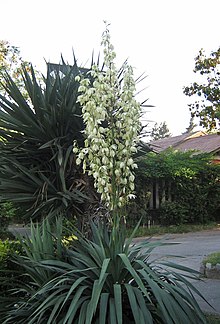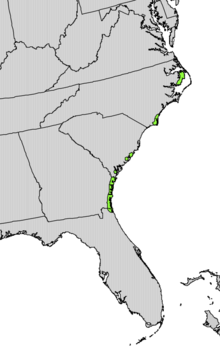
Summary
Yucca gloriosa is a species of flowering plant in the family Asparagaceae, native to the southeastern United States. Growing to 2.5 m (8 ft), it is an evergreen shrub. It is widely cultivated as an ornamental for its architectural qualities, and has reportedly become established in warmer climates in the wild in various parts of the world.
| Yucca gloriosa | |
|---|---|

| |
| Scientific classification | |
| Kingdom: | Plantae |
| Clade: | Tracheophytes |
| Clade: | Angiosperms |
| Clade: | Monocots |
| Order: | Asparagales |
| Family: | Asparagaceae |
| Subfamily: | Agavoideae |
| Genus: | Yucca |
| Species: | Y. gloriosa
|
| Binomial name | |
| Yucca gloriosa | |

| |
| Natural range | |
| Synonyms[1] | |
|
Species synonymy
| |

Names edit
Common names include:-
- Adam's needle
- glorious yucca
- lord's candlestick
- mound lily
- moundlily yucca
- palm lily
- Roman candle
- Sea Islands yucca
- soft-tipped yucca
- Spanish bayonet
- Spanish-dagger[2]
- tree lily
Description edit
Yucca gloriosa is caulescent, usually with several stems arising from the base, the base thickening in adult specimens. The long narrow leaves are straight and very stiff, growing to 30–50 cm (12–20 in) long and 2–3.5 cm (3⁄4–1+1⁄2 in) wide. They are dark green with entire margins, smooth, rarely finely denticulate, acuminate, with a sharp brown terminal spine. The inflorescence is a panicle up to 2.5 m (8 ft) long, of bell-shaped white flowers, sometimes tinged purple or red. The fruit is a leathery, elongate berry up to 8 cm (3 in) long.[3][4][5][6][7]
Taxonomy edit
Yucca gloriosa was first described by Carl Linnaeus in 1753.[8] Genetic evidence has shown that the species originated via multiple hybridizations between Yucca aloifolia and Yucca filamentosa.[9]
Habitat edit
Yucca gloriosa grows on exposed sand dunes along the coast and barrier islands of the subtropical southeastern USA, often together with Yucca aloifolia and a variety formerly called Yucca recurvifolia or Y. gloriosa var. recurvifolia, now Y. gloriosa var. tristis.[10] In contrast to Y. gloriosa var. tristis, the leaves of Y. gloriosa var. gloriosa are hard stiff, erect and narrower. On the other hand, Y. aloifolia has leaves with denticulate margins and a sharp-pointed, terminal spine.
Distribution edit
Yucca gloriosa is native to the coast and barrier islands of southeastern North America, growing on sand dunes. It ranges from extreme southeastern Virginia south to northern Florida in the United States. It is associated with Yucca filamentosa, Yucca aloifolia, and Opuntia species.
Cultivation edit
The plant is widely cultivated in warm temperate and subtropical climates, and valued as an architectural focal point. It has reportedly escaped from cultivation and naturalised in Italy, Turkey, Mauritius, Réunion, Guam, the Northern Mariana Islands, Puerto Rico, Argentina, Chile and Uruguay.[11] In landscape use, little maintenance is needed other than the removal of dead leaves when the shrub nears its ultimate height. The plant is very hardy, without leaf damage at −20 °C (−4 °F), and can handle brief snow and freezing temperatures, as well as long periods of drought. [12]
Yucca gloriosa,[13] and the cultivars 'Variegata'[14] and Bright Star = ‘Walbristar’[15] have gained the Royal Horticultural Society's Award of Garden Merit.[16]
Properties edit
Yucca gloriosa has been known to cause skin irritation and even allergic reactions upon contact. The leaf points are even sharp enough to break the skin.[17]
Forms and varieties edit
In collections in Europe and overseas, there are many forms and hybrids (Sprenger, Förster) from the 18th and 19th centuries. The following names have been used for material of uncertain origin in the European garden flora.
- Yucca gloriosa var. minor Carr.
- Yucca gloriosa var. obliqua Baker
- Yucca gloriosa f. obliqua (Harworth)Voss
- Yucca gloriosa f. acuminata (Sweet)Voss
- Yucca gloriosa f. pruinosa (Baker)Voss
- Yucca gloriosa f. tortulata (Baker)Voss
- Yucca gloriosa' var. medio-striata Planchon
- Yucca gloriosa var. robusta Carr.
- Yucca gloriosa var. nobilis Carr.
- Yucca gloriosa f. planifolia Engelmann|
- Yucca gloriosa var. plicata Engelmann
- Yucca gloriosa var. genuina Engelmann
- Yucca gloriosa var. flexilis Trelease
- Yucca gloriosa var. plicata Carr.
- Yucca gloriosa var. superba Baker
- Yucca gloriosa var. longifolia Carr.
- Yucca gloriosa var. muculata Carr.
- Yucca pendula Sieber ex Carr.
- Yucca pattens Andre
- Yucca pruinosa Baker
References edit
- ^ The Plant List
- ^ BSBI List 2007 (xls). Botanical Society of Britain and Ireland. Archived from the original (xls) on 2015-06-26. Retrieved 2014-10-17.
- ^ RHS A-Z encyclopedia of garden plants. United Kingdom: Dorling Kindersley. 2008. p. 1136. ISBN 978-1405332965.
- ^ Flora of North America v 26 p 429
- ^ Linnaeus, Carl von. 1753. Species Plantarum 1: 319.
- ^ Wunderlin, R. P. 1998. Guide to the Vascular Plants of Florida i–x, 1–806. University Press of Florida, Gainesville.
- ^ Radford, A. E., H. E. Ahles & C. R. Bell. 1968. Manual of the Vascular Flora of the Carolinas i–lxi, 1–1183. University of North Carolina Press, Chapel Hill.
- ^ "Yucca gloriosa L." International Plant Names Index (IPNI). Royal Botanic Gardens, Kew; Harvard University Herbaria & Libraries; Australian National Botanic Gardens. Retrieved 2023-10-05.
- ^ Heyduk, Karolina; McAssey, Edward V.; Grimwood, Jane; Shu, Shengqiang; Schmutz, Jeremy; McKain, Michael R. & Leebens-Mack, Jim (2021), "Hybridization History and Repetitive Element Content in the Genome of a Homoploid Hybrid, Yucca gloriosa (Asparagaceae)", Frontiers in Plant Science, 11: 573767, doi:10.3389/fpls.2020.573767
- ^ World Checklist of Selected Plant Families, The Board of Trustees of the Royal Botanic Gardens, Kew, retrieved 2012-02-23, search for "Yucca recurvifolia"
- ^ Kew World Checklist of Selected Plant Families, Yucca gloriosa
- ^ "cals.arizona.edu". Retrieved 1 March 2007.
- ^ "RHS Plant Selector - Yucca gloriosa". RHS. Retrieved 5 March 2021.
- ^ "RHS Plant Selector - Yucca gloriosa 'Variegata'". RHS. Retrieved 5 March 2021.
- ^ "Bright Star = 'Walbristar'". RHS. Retrieved 11 March 2019.
- ^ "AGM Plants - Ornamental" (PDF). Royal Horticultural Society. July 2017. p. 108. Retrieved 10 March 2019.
- ^ "hgic.clemson.edu". Retrieved 1 March 2007.
External links edit
- http://yuccaagavaceae.com/photos/details.php?image_id=82 Original Erstbeschreibung



